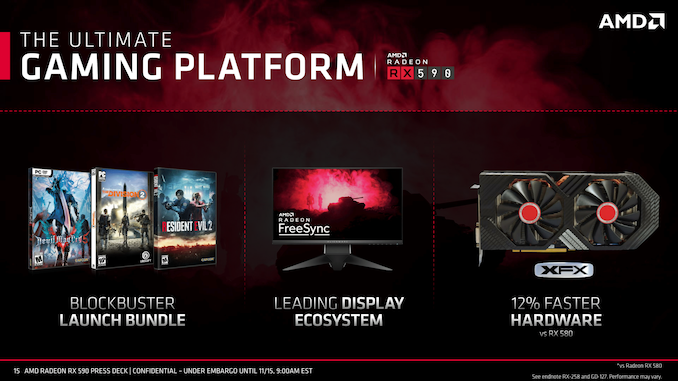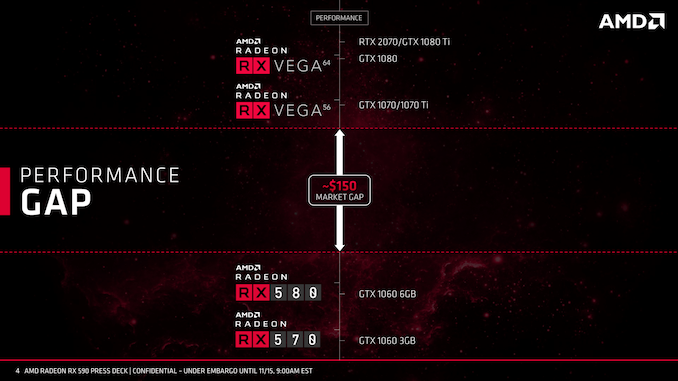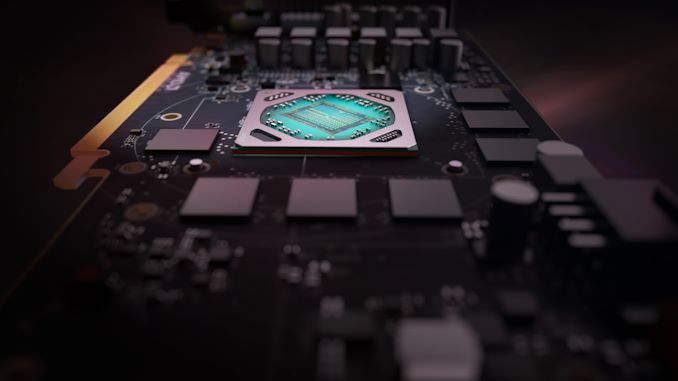The AMD Radeon RX 590 Review, feat. XFX & PowerColor: Polaris Returns (Again)
by Nate Oh on November 15, 2018 9:00 AM ESTClosing Thoughts
As we bring this to a close, the Radeon RX 590 features few, if any, surprises, indeed outperforming the RX 580 via higher clockspeeds but at the cost of additional power consumption. This is enabled by being fabbed on 12nm and being afforded higher TBPs, but in terms of overall effect, the port to 12nm is less of a die shrink and more of a new stepping; in terms of transistor count and die size Polaris 30 is identical to Polaris 10. Feature-wise, whereas the RX 500 series did introduce a new mid-power memory state, the RX 590 doesn't add anything.
Altogether, AMD is helping push the RX 590 along with a three-game launch bundle and emphasizing the value of FreeSync monitors. One might add that the RX 590 also makes the most out of the game bundle, which now presents itself as a direct value-add for the card. But the card by itself isn't providing more bang for your buck than with the RX 580.
By the numbers, then, where does the RX 590 land? Reference-to-reference, the RX 590 is about 12% faster than the RX 580 at 1080p/1440p, and 14-15% faster than the RX 480. Across the aisle, this turns out to be 9% faster than the reference GTX 1060 6GB, though the GeForce card still takes the lead in games like GTA V and Total War: Warhammer II. That matchup itself is more-or-less an indicator of how far Polaris has come - the RX 480 at launch was 11% behind the GTX 1060 6GB, and the RX 580 at launch was 7% behind. Improvements have come over the years with drivers and such, where the RX 480 and RX 580 are much closer, but the third time around, Polaris can finally claim the victory at launch.
That being said, the 9% margin is well within reach of factory-overclocked GTX 1060 6GB cards, especially with a 9Gbps option that the RX 590 doesn't have. Even with the XFX Radeon RX 590 Fatboy the delta only increases to about 11%. In other words, as custom factory-overclocked cards the RX 590 and GTX 1060 6GB are likely to trade blows. And heavily factory-overclocked RX 580s are in the similar situation.
But similar to the RX 580 and 570, the RX 590 achieves this at the cost of even more power consumption. In practical situations like in Battlefield 1, the RX 590 results in the system pulling around 110W more from the wall than with the GTX 1060 6GB. The RX 590 is not a power efficient card at the intended clocks and TBP, and so won't be suitable for SFF builds or reducing air conditioning usage.
Once again though, we've observed that VRAM is never enough. It was only a few years ago that 8GB of VRAM was considered excessive, only useful for 4K. But especially with the popularity of HD texture packs, even 6GB of framebuffer could prove limiting at 1080p with graphically demanding games. In that respect, the RX 590's 8GB keeps it covered but also brings additional horsepower over the 8GB R9 390. For memoryhogging games like Shadow of War, Wolfenstein II, or now Far Cry 5 (with HD textures), the 8GBs go a long way. Even at 1080p, GTX 980/970 performance in Wolfenstein II tanks because of the lack of framebuffer. For those looking to upgrade from 2GB or 4GB cards, both the RX 580 and RX 590 should be of interest.
So in terms of a performance gap, the custom RX 590s seem poised to fill in, though it might be in the range of 5 to 10% when comparing to existing heavily factory-overclocked RX 580s. That gap, of course, would likely have been filled by a 'Vega 11' product, which never came to fruition. Beyond a smaller discrete Vega GPU, 12nm Vega seems less likely given that 14nm+ Vega is no longer on the roadmap. And with 7nm Vega announced as Radeon Instinct MI60 and MI50 accelerators, there's no current indication of those GPUs coming into the consumer space. We also know very little about Navi other than being fabbed with TSMC on 7nm and due in 2019.
So of the possible cards in AMD’s deck, we are seeing a single 12nm Polaris SKU slotting in above the existing RX 580. If there are no further refreshes coming, then gamers will naturally ask when Polaris will be replaced as AMD's mainstream offering, as otherwise the RX 500 series will be holding the fort until then. If this is a prelude to further refreshes, then it becomes a question of how much more performance can be squeezed from Polaris.
The bigger picture is that from the consumer point-of-view, RX Vega in August 2017 was the most recent video card launch before today. There are more pressing concerns in the present: NVIDIA's recently-launched Turing-based GeForce RTX 20 series, as well as Intel's renewed ambition for discrete graphics and subsequent graphics talent leaving AMD for Intel. While the RX 590 avoids the optics of having no hardware response whatsoever in the wake of the RTX 20 cards, it is still a critical juncture with respect to DirextX Raytracing (DXR) development. And regardless, Intel has announced 2020 as the date for their modern discrete GPUs.
So as we head into 2019, it will be a crucial year for AMD and RTG. But returning to the Radeon RX 590, it applies pressure to the GTX 1060 6GB and older GTX 900 series cards, while avoiding direct pressure on existing RX 580 inventory by virtue of pricing. And right now, without anything to compete with the GTX 1080 Ti/RTX 2070 range or above, AMD is likely more than happy to take any advantage where they can. For now, though, much depends on the pricing of top-end RX 580s.













136 Comments
View All Comments
Kriswithak - Thursday, November 15, 2018 - link
I would love to see if the improved process offers better efficiency.With the RX480 4gb, I undervolted the card and saw a significant decrease in load power consumption.
With the RX580 8gb, I dropped the boost clocks a bit and dropped the voltage as well, and only used 6 pin power connector.
I would like to see the rx590/580/480 at similar reference/boost clocks, then undervolted to lowest possible stable and see what the frame per watt comparison is.
Nfarce - Thursday, November 15, 2018 - link
Just another example of AMD shooting their R&D wad at the APU/CPU segment and ignoring the GPU segment. There is ZERO reason to buy this fail over Nivdia unless you have already bought a Freesync monitor and a much older AMD GPU, which monitors, by the way, do work with Nvidia GPUs when locking down the v-sync tool. I have a Freesync 75Hz monitor ( 32" 1440p AOC) and love it with my GTX 1070 Ti locking in frames (bought it for $369 on NewEgg in a promo sale). Said 1070 Ti doesn't even need to breathe hard. Minimum FPS never comes close to hitting 75 FPS. Not only is it 30+% faster, but it also consumes nearly 20% less power under load than this card. Yeah, that's worth the extra $80 for my 1070 Ti in my book. You get what you pay for. I really hope AMD starts using some of their Ryzen revenue that they've been taking in for - nearly three years now mind you and not including their revenue stream from game console APUs - into upping their dedicated GPU game. Because they have a long way to go to match Nvidia in the upper tiers where the real price margin revenue is made. Nobody makes money on low and mid range GPUs where AMD has always targeted.eva02langley - Friday, November 16, 2018 - link
You are missing the point here, Lisa Su said that decision are took 3-5 years in advance for their roadmap.Polaris was already a thing and just making a 12 nm was an easy thing to do and was filling a gap.
People tend to forget that the 8GB RX 580 MSRP is actually 240$, not 200$ which is for the 4GB version. 30$ more is not such a step and still the cost per FPS is one of the lowest.
With a 100$+ of game bundle to add to it, there is no question that the value is there.
Flunk - Thursday, November 15, 2018 - link
Slightly overclocked RX 480 from two years ago? Wake me when AMD actually releases a new GPU.Cyborg997 - Thursday, November 15, 2018 - link
Can't believe this s*** with an AMD. 3 years with the same chips. What the f*** please give us something worth our money. Still have my Fury 9 runningAssimilator87 - Friday, November 16, 2018 - link
While everyone upped their resolution to UHD, I went the opposite direction and am running a CRT at 720p. My 7970's still running strong lol. CPU market is fire right now, but GPUs so boring =\piroroadkill - Friday, November 16, 2018 - link
So it sits somewhere between the 1060 6GB and 1070, most of the time closer to the former, and yet consumes a lot more power than either card. No thanks. People don't want noisy, hot systems these days without actually getting some performance to back it up.eva02langley - Friday, November 16, 2018 - link
It is actually quieter... check higher... seriously... people.Lolimaster - Friday, November 16, 2018 - link
It's really sad that 2 years after, performance per dollar went down.2 years more and we will have an APU with similar power than the RX580 on a $150 chip...
ItsAlive - Friday, November 16, 2018 - link
Now undervolt and overclock that gtx 1060, Mine was able to drop over 100mv, lowered power limit to 75%, but still overclocked 200/400 core/mem clocks and uses 75w max at full load. Temps typically run mid 60s with stock fan settings and its near silent. Its a mini card that is probably 1/3 the size of the RX590 and I bought it over a year ago for $250.If a stock gtx1060 uses typcially 120 watts max (mine would before the undervolt), then total system power for an undervolted card according to the charts in the article would look like this:
GTX1060/RX590/Fatboy
--------------------------------
BF1: 210w/363w/379w
Furmark: 206w/330w/362w
I would be interested to see an undervolted RX590 vs undervolted GTX1060 for a better comparison.